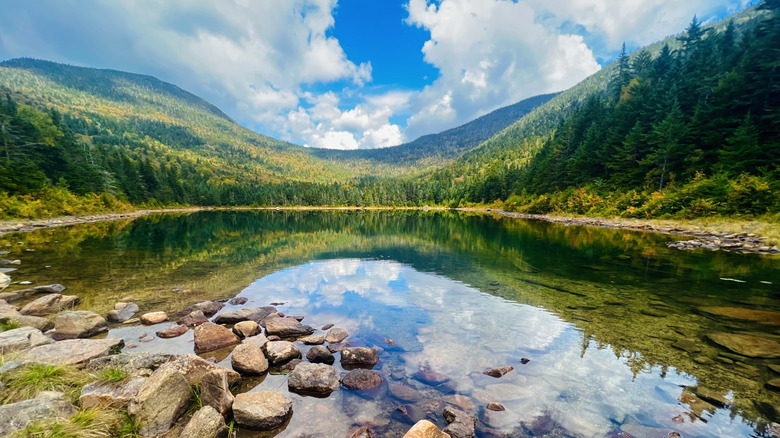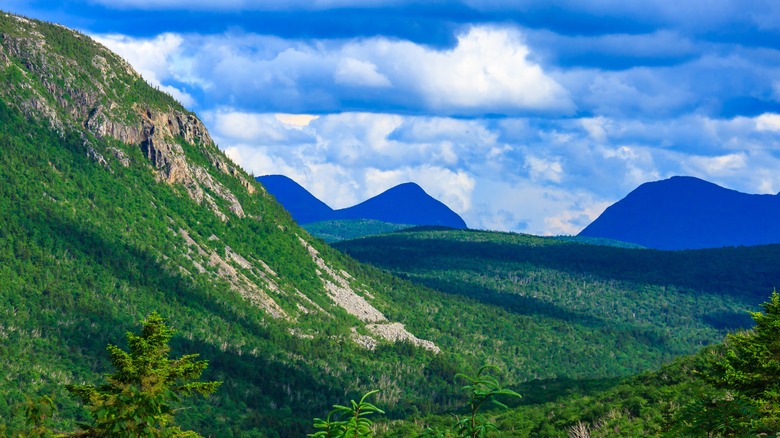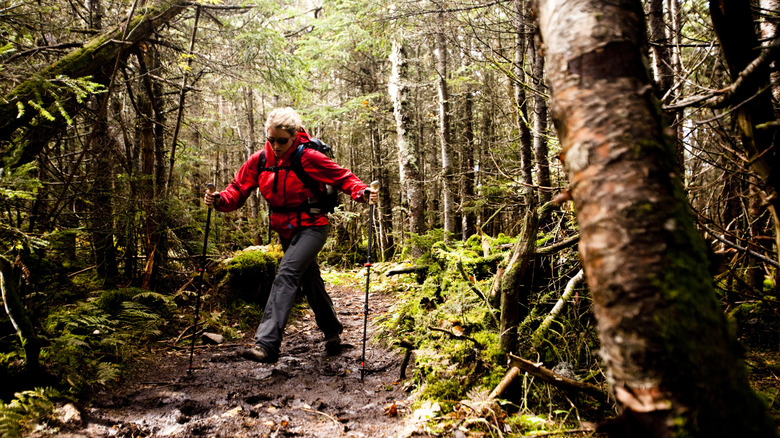The 'Cleanest, Purest, Bluest Water In The Granite State' Is A Crystalline New England Swimming Hole
Of the many pleasures of summer in northern New England, few exceed the cool caress of mountain water at the local swimming hole. Rippling along stony streams and creeks, the snowmelt and spring water collect in pools and ponds to become the ultimate refreshment. Which one is the best remains a regular topic of debate for locals — whether it's this secret clear lake in the White Mountains or the breathtaking waterfall and swimming hole at the "Little Grand Canyon." Another contender is East Pond in Thornton. Zoomed in, it can appear as "the purest, cleanest, bluest water in the Granite State" (per 97.5 WOKQ). Zoom out, and watch the frame reveal an alpine tapestry of pine, spruce, fir, and birch that typifies New Hampshire forests.
Measuring 6.5 acres and 27 feet deep, East Pond sits in a hollow of White Mountain National Forest. As such, it comes with all the nature of the region: dense greenery, rocky soil, cool air, and limited light. That also translates to abundant wildlife, including black bear, bobcat, moose, deer, and snakes. Often, it's flying above as woodcocks, warblers, bats, hawks, and other species that are precious to birders. In East Pond itself, you may find leeches among its watery critters. They are extremely common in northern New England, not dangerous, and are easily removable with the slide (not a pull) of a fingernail or blade.
Hiking to East Pond in New Hampshire
No straight road goes to East Pond, just a hiking trail. From the trailhead on Tripoli Road (closed in winters), the trail forms a 5-mile loop that connects East Pond with its smaller sister, Little East Pond, before returning. Although categorized as "easy-moderate," the loop still requires a certain amount of fitness and mobility to navigate the sometimes uneven path and ascend the gentle 1,000 feet of total elevation. Accompanying the journey is a living landscape rich with towering spruce, mossy rocks, babbling brooks, bright flowers, robust mushrooms, and the occasional pile of wildlife poop. From the loop, East Pond Trail continues 3.5 miles north, where it connects to a second trailhead at the Kancamagus Highway — one of America's most spectacular fall foliage drives.
A trip to East Pond also offers a history lesson that begins with the name of Tripoli Road. Another name for diatomaceous earth — made from the fossils of tiny, aquatic organisms called diatoms — Tripoli was mined from East Pond from 1911 to 1919. The venture was ultimately unsuccessful, but a few remains are still visible along the way, as a portion of the hiking loop follows the path of the railroad track that once ran here. The story also sheds light on how important mining, including a minor gold rush in 1864, was to the growth and development of New Hampshire. Some of these mines, such as Ruggles Mine (just over an hour away from the trailhead), are now open to the public as tourist attractions.
Travel tips for your adventure to East Pond
Access to East Pond is available all year, albeit the winter months make it far more difficult, owing to the snow, ice, and closed Tripoli Road. The warmest months offer the best conditions for both hiking and swimming in East Pond. The best way to arrive is by car, as Tripoli Road lies right off Interstate 93 at Exit 31, 88 miles north of the nearest major airport, Manchester-Boston Regional Airport, and 67 miles from Lebanon Municipal Airport, connecting Boston and White Plains, New York. Concord Coach Lines does run buses into the area, but a car remains necessary to reach the East Pond trailheads.
Thanks to regular tourism in the White Mountains, hotels, motels, B&Bs, and campgrounds are aplenty near East Pond, especially a few miles up the highway in North Woodstock. Most are in the two-to-three-star range, but the four-star Owl's Nest Resort is a short drive away. Arguably more important than the hotel is what you pack. In any season, the northern New England landscape can be challenging, so be sure to bring the proper footwear, clothes, and supplies wherever you go. Bug spray is essential in the warm months, and tick removal devices are a good idea. Cell phone signals struggle in the geography, too, making it prudent to download offline support ahead of time, like the White Mountain National Forest Smartphone App.


